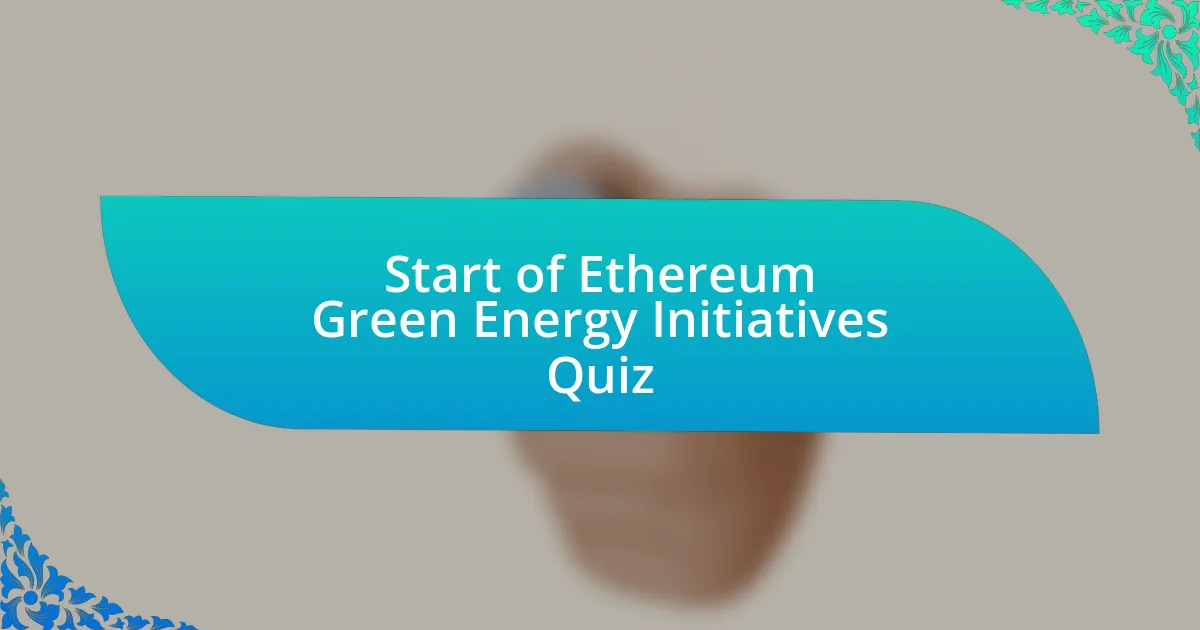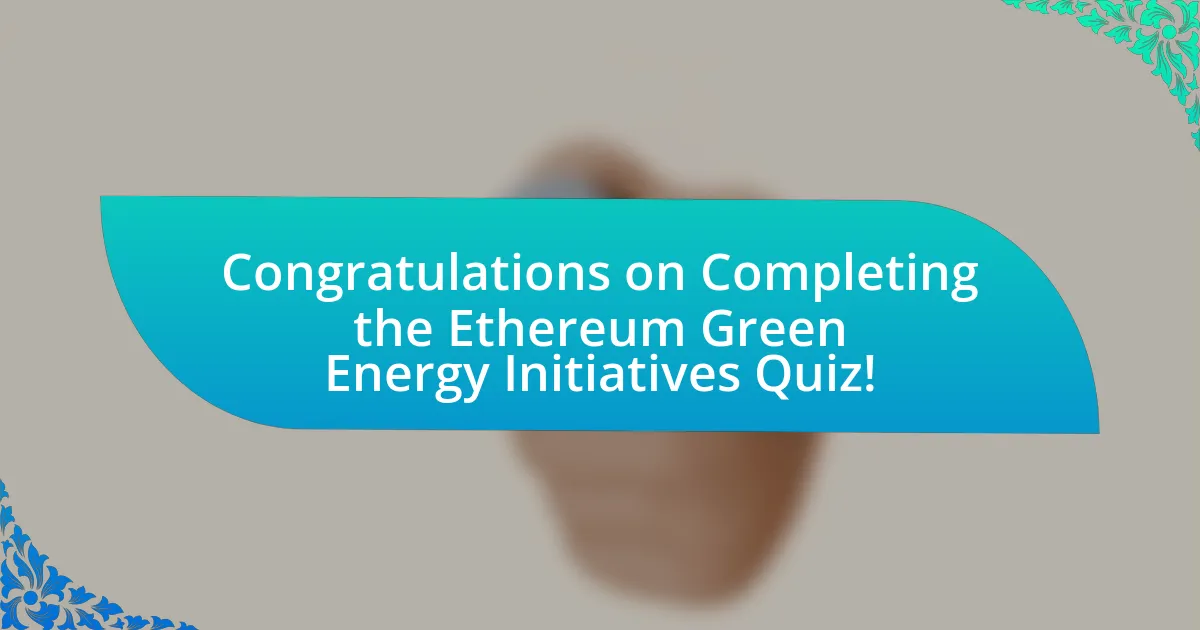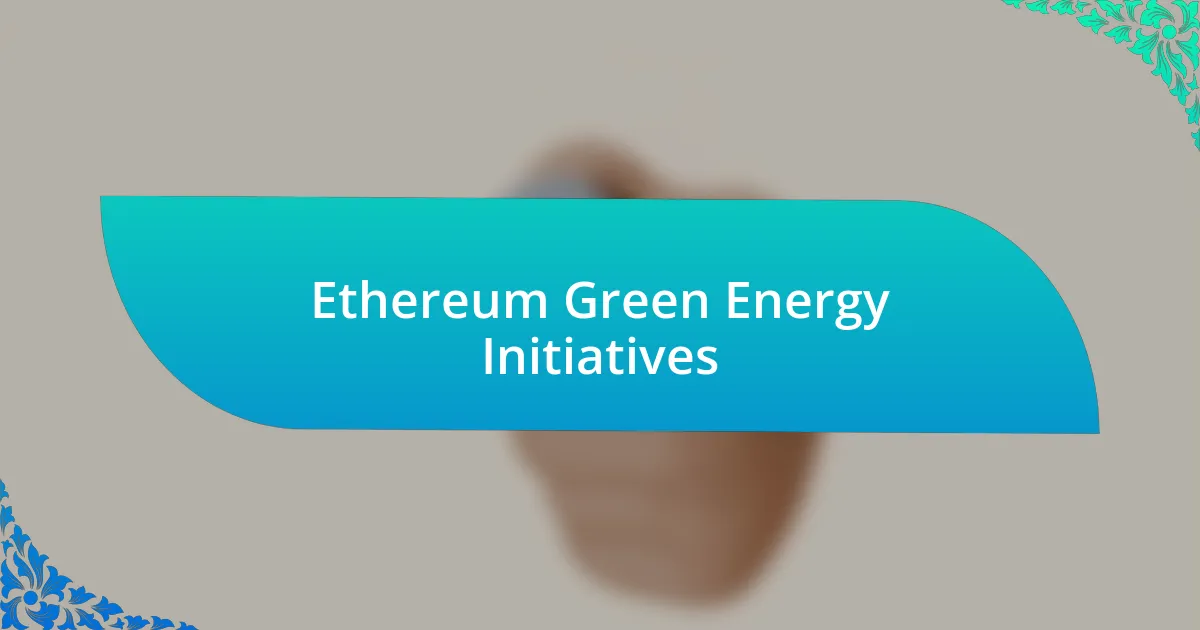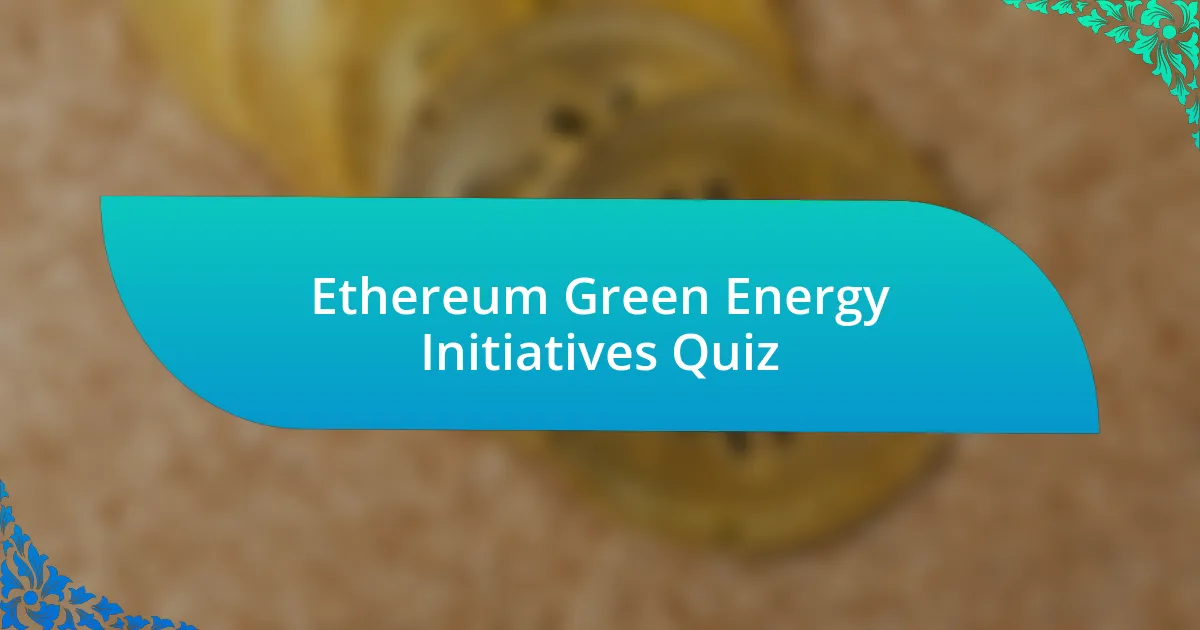
Start of Ethereum Green Energy Initiatives Quiz
1. What is Ethereum`s primary goal regarding sustainability?
- To mitigate the environmental impact of blockchain technology and promote sustainable development.
- To promote cryptocurrency trading among users globally.
- To enhance security through decentralized data storage.
- To increase transaction speeds and reduce fees for users.
2. What is the Ethereum Foundation doing to support sustainability?
- The Ethereum Foundation is investing in fossil fuel projects to increase energy production.
- The Ethereum Foundation is partnering with renewable energy projects to offset carbon emissions associated with Ethereum mining.
- The Ethereum Foundation is ignoring sustainability issues related to blockchain technology.
- The Ethereum Foundation is promoting traditional mining practices to boost efficiency.
3. What is the transition to PoS in Ethereum?
- The transition to proof-of-work (PoW) enhances Ethereum`s smart contract capabilities.
- The transition to proof-of-stake (PoS) significantly reduces Ethereum`s energy consumption.
- The transition to proof-of-work (PoW) increases Ethereum`s transaction speed.
- The transition to proof-of-stake (PoS) allows Ethereum to mine new coins.
4. How does Ethereum`s energy consumption compare to other technologies?
- Ethereum consumes the same amount of energy as traditional banking systems.
- Ethereum consumes more energy than coal-fired power plants.
- Ethereum consumes more energy than all global data centers combined.
- Ethereum consumes less energy than video gaming in the U.S. and less than Google.
5. What percentage of Ethereum`s energy comes from sustainable sources?
- 35%
- 48%
- 25%
- 60%
6. What are some examples of sustainable mining practices in the Ethereum ecosystem?
- Utilizing only fossil fuels and minimizing community engagement.
- Promoting coal-based mining operations and reducing regulatory oversight.
- Advocating for eco-friendly mining practices and developing energy-efficient validation methods.
- Increasing energy consumption and neglecting environmental regulations.
7. What is SolarX`s approach to cryptocurrency mining?
- SolarX uses renewable energy sources, particularly solar power, to power its mining operations.
- SolarX uses hydroelectric power only for its mining operations.
- SolarX relies on fossil fuels to operate its mining facilities.
- SolarX focuses exclusively on cryptocurrency trading and not mining.
8. How does SolarX reduce carbon emissions?
- SolarX reduces carbon emissions by using fossil fuels more efficiently.
- SolarX significantly reduces carbon emissions by harnessing the power of renewable energy sources.
- SolarX reduces carbon emissions by implementing carbon capture technologies.
- SolarX reduces carbon emissions by increasing the number of mining operations.
9. What is the role of the SolarX token in the ecosystem?
- The SolarX token is a stablecoin, designed to maintain a fixed value tied to traditional currencies.
- The SolarX token serves as a utility token, enabling users to participate in governance, access exclusive features, and benefit from incentives.
- The SolarX token functions as a reward token, only letting users earn tokens through mining activities.
- The SolarX token acts as a security token, providing users with ownership stakes in the mining operations.
10. What is the community-driven governance mechanism in SolarX?
- The governance is centralized and controlled by a board.
- Token holders can actively participate in decision-making processes through decentralized governance mechanisms.
- Only developers can vote on key decisions.
- Users need to hold a minimum balance of fiat currency to participate.
11. How does Ethereum 2.0 reduce energy consumption?
- Ethereum 2.0 reduces energy consumption by transitioning from proof-of-work to proof-of-stake.
- Ethereum 2.0 reduces energy consumption by requiring users to mine every transaction.
- Ethereum 2.0 reduces energy consumption by using more powerful mining equipment.
- Ethereum 2.0 reduces energy consumption by increasing the block size for transactions.
12. What is the energy consumption of Ethereum per year?
- 0.0026 terawatt-hours per year (TWh/yr)
- 10 terawatt-hours per year (TWh/yr)
- 1.5 terawatt-hours per year (TWh/yr)
- 5 terawatt-hours per year (TWh/yr)
13. How much carbon dioxide does Ethereum produce annually?
- Ethereum produces 2,200 tonnes of carbon dioxide annually.
- Ethereum produces 1,500 tonnes of carbon dioxide annually.
- Ethereum produces the equivalent of 870 tonnes of carbon dioxide annually.
- Ethereum produces 300 tonnes of carbon dioxide annually.
14. What is the significance of the Merge in Ethereum?
- The Merge eliminated all transaction fees on the Ethereum network.
- The Merge resulted in a new cryptocurrency entirely separate from Ethereum.
- The Merge integrated the transition to proof-of-stake, reducing energy consumption and promising faster transactions and lower gas fees.
- The Merge increased Ethereum`s mining rewards significantly for all validators.
15. What is blockchain-based carbon offsetting?
- Blockchain-based carbon offsetting facilitates traditional banking transactions with lower fees.
- Blockchain-based carbon offsetting is a method for creating new cryptocurrencies through mining.
- Blockchain-based carbon offsetting refers to tracking weather data in real-time.
- Blockchain-based carbon offsetting involves purchasing and trading carbon credits on a decentralized marketplace.
16. How does blockchain facilitate peer-to-peer energy trading?
- Blockchain facilitates peer-to-peer energy trading by allowing consumers to buy and sell excess energy generated from renewable sources.
- Blockchain restricts energy trading to utility companies and central authorities.
- Blockchain enables energy trading by automating energy consumption diagnostic tools.
- Blockchain helps peer-to-peer energy trading by tracking fossil fuel usage accurately.
17. What is the potential role of Ethereum in promoting renewable energy adoption?
- Ethereum will prohibit the use of renewable energy in its network completely.
- Ethereum can promote renewable energy adoption by facilitating decentralized energy markets and incentivizing renewable energy production.
- Ethereum can replace existing power grids with centralized energy sources only.
- Ethereum can encourage fossil fuel use by providing subsidies to mining companies.
18. What is the partnership between Vanar and Google Cloud?
- Vanar and Google Cloud are working to eliminate all data centers globally.
- Vanar and Google Cloud are developing a completely offline energy solution.
- Vanar and Google Cloud are creating a new cryptocurrency entirely separate from blockchain technology.
- Vanar and Google Cloud collaborate to optimize the utilization of Google`s cloud infrastructure while reducing carbon emissions.
19. What is Vanar`s vision for a carbon-neutral blockchain?
- Vanar aims to create a carbon-neutral blockchain aligned with Google Cloud`s sustainability goals.
- Vanar seeks to establish a fully decentralized blockchain without any carbon emissions.
- Vanar intends to develop a blockchain that only operates on fossil fuels.
- Vanar`s vision is to integrate a traditional banking system with a carbon-neutral approach.
20. How does Google Cloud contribute to sustainability?
- Google Cloud aims to eliminate all cloud-based services to decrease energy consumption.
- Google Cloud only focuses on reducing server costs and has no sustainability goals.
- Google Cloud provides free energy-efficient hardware for all users.
- Google Cloud aims to run all data centers on carbon-free energy by 2030 and has been carbon-neutral since 2007.
21. What is the significance of the intersection of blockchain and renewable energy?
- Blockchain eliminates the need for renewable energy sources entirely.
- Blockchain hinders renewable energy development by creating inefficiencies.
- Blockchain technology supports renewable energy production by tokenizing energy and promoting sustainable practices.
- Blockchain reduces the cost of fossil fuels and increases their usage.
22. How do renewable energy producers benefit from blockchain technology?
- Renewable energy producers can directly store energy using blockchain technology without any physical infrastructure.
- Renewable energy producers can issue tokens to exchange or sell on blockchain networks, symbolizing the energy produced and providing new sources of income.
- Renewable energy producers can only generate profits by solely investing in traditional energy sources through blockchain.
- Renewable energy producers can trade stocks immediately on major exchanges and reduce operational costs significantly.
23. What is the example of a wind farm distributing tokens?
- A wind farm plans to issue tokens only during high wind seasons.
- A wind farm generates tokens only for maintenance operations.
- A wind farm could sell tokens to local governments every year.
- A wind farm might distribute tokens for each megawatt-hour of electricity generated.
24. How do blockchain-based tokens promote sustainability?
- Blockchain-based tokens discourage investment in energy-efficient technologies and sustainable practices.
- Blockchain-based tokens give producers new sources of income and promote more spending on infrastructure related to renewable energy.
- Blockchain-based tokens solely support traditional energy markets without any benefit to renewables.
- Blockchain-based tokens increase fossil fuel consumption and decrease renewable investment.
25. What is the role of transparency in blockchain-based carbon offsetting?
- Blockchain-based carbon offsetting restricts access to carbon credits for users.
- Blockchain-based carbon offsetting eliminates the need for transparency in carbon markets.
- Blockchain-based carbon offsetting provides a transparent way to track and verify carbon emissions reductions.
- Blockchain-based carbon offsetting complicates the verification of carbon emissions reductions.
26. How does decentralized energy trading benefit consumers?
- Decentralized energy trading fosters greater energy independence and resilience by allowing consumers to buy and sell excess energy generated from renewable sources.
- Decentralized energy trading limits consumer options by restricting access to traditional energy markets.
- Decentralized energy trading has no effect on consumer costs or energy sourcing decisions.
- Decentralized energy trading only benefits large corporations while leaving consumers dependent on central authority.
27. What is the impact of blockchain technology on the renewable energy sector?
- Blockchain technology can revolutionize the renewable energy sector by facilitating decentralized energy trading, transparent carbon offset markets, and incentivizing sustainable energy production.
- Blockchain technology primarily focuses on financial transactions and is not relevant to renewable energy development.
- Blockchain technology has little to no impact on the renewable energy sector as traditional methods suffice.
- Blockchain technology complicates the renewable energy sector by introducing unnecessary layers of complexity.
28. What is the collaboration between Vanar and Google Cloud aiming to achieve?
- The collaboration aims to develop a new cryptocurrency exclusively for Google Cloud services.
- The collaboration aims to create an ecologically beneficial and carbon-neutral blockchain by optimizing the utilization of Google`s cloud infrastructure.
- The collaboration is designed to improve data storage solutions for cryptocurrency users.
- The collaboration focuses on building a more efficient search engine for cloud users.
29. How does Vanar`s vision align with Google Cloud`s sustainability goals?
- Vanar plans to ignore sustainability and prioritize expansion over eco-friendliness.
- Vanar aims to increase fossil fuel usage in blockchain operations to decrease costs.
- Vanar`s plan focuses solely on maximizing profits without environmental considerations.
- Vanar`s vision of a carbon-neutral blockchain aligns with Google Cloud`s sustainability efforts.
30. What percentage of Ethereum`s energy is powered by natural gas, coal, and oil?
- 52%
- 30%
- 65%
- 47%

Congratulations on Completing the Ethereum Green Energy Initiatives Quiz!
We hope you enjoyed the quiz and gained valuable insights into Ethereum’s green energy efforts. Understanding how blockchain technology intersects with sustainability is crucial today. Many of you may have learned about the various initiatives Ethereum is undertaking to reduce its carbon footprint and promote renewable energy sources.
Through this quiz, you might have discovered the significance of proof-of-stake as a more energy-efficient alternative to proof-of-work. You also likely explored how Ethereum projects aim to innovate and lead in the transition toward a more sustainable future. Such knowledge can empower you to engage more thoughtfully with blockchain technology and its environmental impacts.
As you continue your journey, we invite you to check out the next section on this page. It offers in-depth information about Ethereum’s green energy initiatives. This resource will deepen your understanding and keep you informed about ongoing developments in this critical area. Happy learning!

Ethereum Green Energy Initiatives
Understanding Ethereum’s Transition to Green Energy
Ethereum’s transition to green energy initiatives primarily revolves around its shift from a proof-of-work (PoW) consensus mechanism to proof-of-stake (PoS). This significant change reduces energy consumption drastically. PoW systems require intensive computational resources and energy to validate transactions, while PoS allows validators to create new blocks based on the number of coins they hold and are willing to “stake,” which greatly minimizes energy use. The Ethereum Foundation estimates that this transition will lower energy consumption by up to 99.95%.
Impact of Proof-of-Stake on Energy Consumption
The implementation of PoS directly impacts Ethereum’s carbon footprint. Unlike PoW, which relies on vast mining networks and GPUs, PoS eliminates the need for power-hungry mining operations. This shift allows Ethereum to align itself with global sustainability goals, making it more appealing to environmentally conscious investors and users. By minimizing energy requirements, Ethereum positions itself as a leader in eco-friendly blockchain technology.
Partnerships and Collaborations for Sustainability
Ethereum has engaged in various partnerships aimed at enhancing its green energy initiatives. Collaborations with firms specializing in renewable energy aim to offset the network’s carbon emissions. These partnerships also promote the adoption of clean energy sources such as solar and wind for powering data centers and network validators. Proof of these initiatives exists in various reports showcasing Ethereum’s commitment to sustainability and its influence on the broader crypto community.
Ethereum’s Role in Carbon Offset Projects
Ethereum participates in carbon offset projects to counterbalance its environmental impact. These projects involve investing in initiatives that reduce carbon emissions, such as reforestation and renewable energy installations. The Ethereum Foundation backs projects that promote transparency and accountability, ensuring that emissions reductions are verifiable and impactful. This strategic involvement helps build Ethereum’s reputation as a blockchain that prioritizes environmental responsibility.
Future of Ethereum and Renewable Energy Integration
The future of Ethereum includes ongoing improvements in sustainability practices. Plans to further integrate renewable energy sources into network operations are underway, focusing on encouraging validators to utilize green energy. There are initiatives to create incentives for mining operations to use renewable resources. This approach aims to establish a fully sustainable blockchain ecosystem, contributing positively to both the crypto industry and global environmental efforts.
What are Ethereum Green Energy Initiatives?
Ethereum Green Energy Initiatives refer to efforts aimed at reducing the environmental impact of Ethereum’s blockchain operations. These initiatives include transitioning to a proof-of-stake (PoS) consensus mechanism, which significantly lowers energy consumption. For instance, Ethereum’s upgrade to Ethereum 2.0 is a pivotal change that has reduced energy usage by approximately 99.95%, making it one of the most eco-friendly blockchain platforms.
How does Ethereum contribute to green energy solutions?
Ethereum contributes to green energy solutions primarily through supporting projects that aim to utilize renewable energy sources for blockchain operations. By encouraging the development of decentralized applications (dApps) focused on sustainability, Ethereum helps promote the use of green energy. Additionally, initiatives like the Ethereum Foundation’s backing of research into eco-friendly technologies and energy-efficient models enhance the overall green energy landscape.
Where are Ethereum Green Energy Initiatives being implemented?
Ethereum Green Energy Initiatives are being implemented globally, with notable projects in countries like Canada, where hydropower is abundant, and in regions harnessing solar and wind energy. Data centers using renewable energy sources to power Ethereum nodes are increasingly common. Additionally, there are various partnerships formed internationally aimed at increasing the adoption of green energy practices within the Ethereum network.
When did Ethereum start focusing on green energy initiatives?
Ethereum began focusing on green energy initiatives with the proposal of Ethereum 2.0 in late 2018, highlighting a shift towards sustainable practices. The transition away from the energy-intensive proof-of-work (PoW) model, which culminated with the network’s merge in September 2022, marked a significant commitment towards reducing carbon footprints associated with blockchain operations.
Who is behind Ethereum Green Energy Initiatives?
The Ethereum Foundation, along with a network of developers, researchers, and community advocates, is behind Ethereum Green Energy Initiatives. This group promotes the transition to proof-of-stake and supports various eco-centric projects within the Ethereum ecosystem. Collaborations with organizations and projects that emphasize sustainability further strengthen these initiatives, fostering a commitment to greener technologies.

